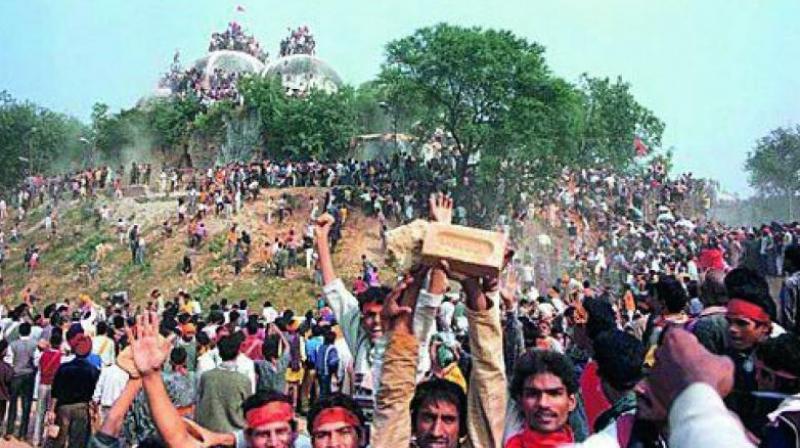25 years later, Ayodhya is now on backburner

The liberals and secularists mourn December 6 as a black day, as the day Indian secularism lay in tatters. The Hindutva mob which had brought down the 16th century mosque which is strangely called the Babri Masjid on this day in 1992 had all but melted away. The BJP under L.K. Advani, then its lodestar, suddenly felt deflated. The political goals were not served. In 1996 it failed to form the government. No one from the non-Congress Opposition ranks would join hands with them. It altered a little in 1998 and 1999, but even on these two occasions the BJP under Prime Minister Atal Behari Vajpayee barely managed to be in power. The Hindutva logic should have led to the building of the temple in the years that followed. Even as the mob brought down the mosque, the party could have found a hundred subterfuges to erect the temple.
It will be argued by the right-wing apologists that it was a sense of fairness and decency on the part of the BJP, and its affiliates — the Ras-htriya Swayamsevak Sangh (RSS), Vishwa Hindu Parishad (VHP), Bajrang Dal and the rest of the mobsters who were there that day in Ayodhya. But it is quite evident that this was not the case. The BJP and the Hindu right felt deflated after the destruction of the Babri Masjid. They could not any more use it to inflame passions to win elections, which of course they did not.
The liberals and secularists among the politicians should have dealt firmly with the situation. They should have pursued the criminal case against the BJP, VHP et al and got them sent to prison. And they should have reconstructed the mosque as required in the criminal law of the country when a building is unlawfully pulled down. The then Prime Minister P.V. Narasimha Rao is the first guilty man, not for preventing the destruction of the mosque, but for not reconstructing it, and for not objecting to the Supreme Court allowing the temporary structure housing the Ram Lalla idols to be protected. Those who raged against the destruction were not vocal enough about the reconstruction of the mosque. It became a talking point, but nothing more.
As the years pass, the BJP and the others maintain a strange silence, working out ways to construct the Ram temple and more so when the elements of the future temple are all in place in a yard in Ayodhya. The BJP leaders seem to be weighing the options. They seem to be calculating the advantages — political and electoral — that could accrue to them. The destruction of the mosque left them nonplussed. They seem to be confused about the usefulness of building the temple despite their claims to be determined to do so.
Soon after December 6, 1992, the BJP had realised that it could not be the party of the Ram temple as a majority of Hindus across India are not really interested in a Ram temple in a backward town of Uttar Pradesh. Ayodhya is not central enough for the Hindu religious imagination. The Ram of the Hindus is to be found in myriad texts starting from Valmiki’s Ram-ayan, a poetical work, and continues in the poetical tradition in the works of 9th century CE Kamban in Tamil and the 16th century Ramcharitmanas of Tulsidas in Hindi. So the BJP read the mind of the Hindus totally wrong. Building a temple for their religious and cultural hero wasn’t the way to win their hearts and votes. Hence the Ram temple in Ayodhya issue dangles in the air, a meaningless political pendant.
The Ram temple issue is literally on the backburner for now for the BJP. The temple is sure to come up through fair and foul means. But there is no sense of political urgency, and the existential angst was never there in the first place. The liberals and leftists, including the Muslims, were foolish enough to lay all their eggs in the basket of the Babri Masjid. The destruction of the mosque bruised their minds and souls no doubt, but it did not destroy secularism in India. The people of the country, Hindus and Muslims especially, have left the ugly episode far behind. The cynical Narasimha Rao had said as much in his reply to the no-confidence motions that the BJP had brought against his government in the wake of the destruction of the mosque in the Lok Sabha on December 17, 1992. The most ignominious role in that debate was that of Atal Behari Vajpayee, and the most noble was that of Sunil Dutt. The actor made the poignant observation that everyone was talking about how to build the temple and the mosque, but no one had a word for the thousand people who were killed in the riots across the country that followed the destruction of the temple, of the widows and orphans left behind by the killings. The liberals have been fixated on the Babri Masjid, but they barely mention those killed in the riots. For them, the mosque symbolised secularism and not the lives of the people which were lost.
We can see that the sense of outrage of the secularists over the destruction of the mosque has become tepid after a quarter century. And truth be told, Ayodhya mosque/temple dispute was never central to the lives of the people. It was a controversy of the times and it died a natural death. The Muslims are today the largest, vibrant religious group in the country and they are not afraid of the BJP. They are aware that their faith is stronger and deeper than the ephemeral structure of the Babri Masjid. Only the ignorant leaders of the community continue to harp on the idolatrous description “martyrdom of the mosque”. People become martyrs, not structures of stone.

